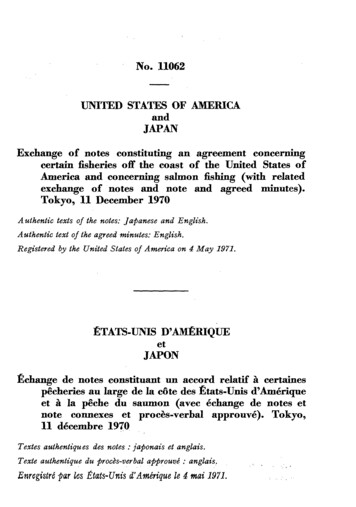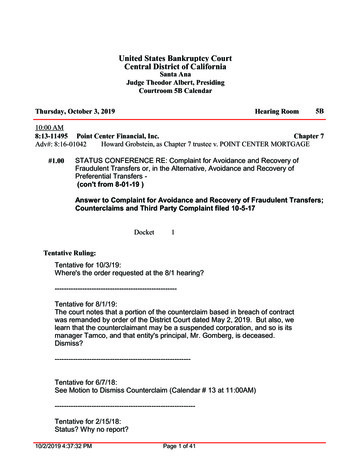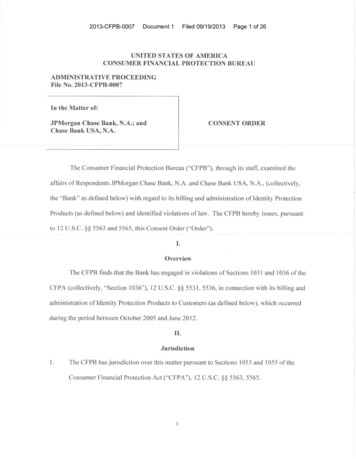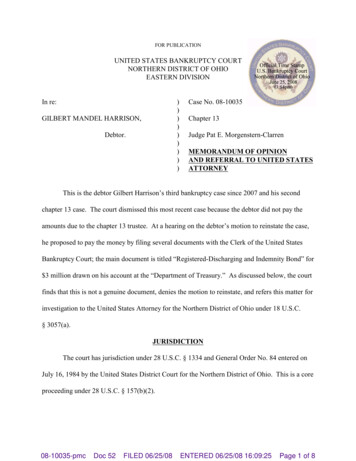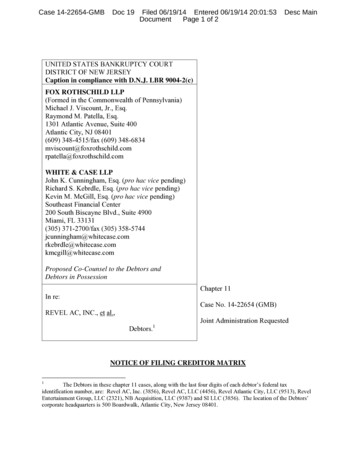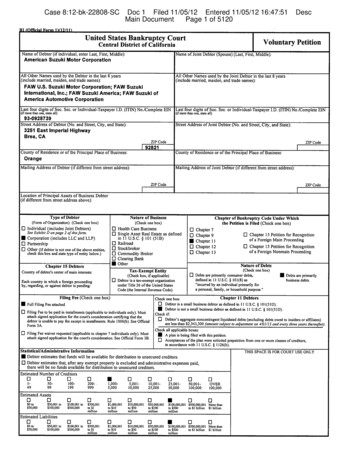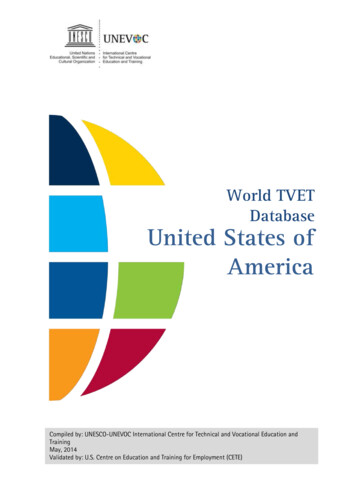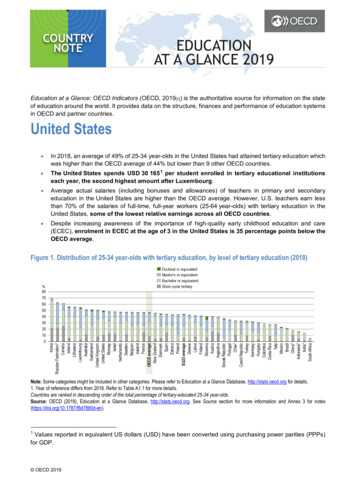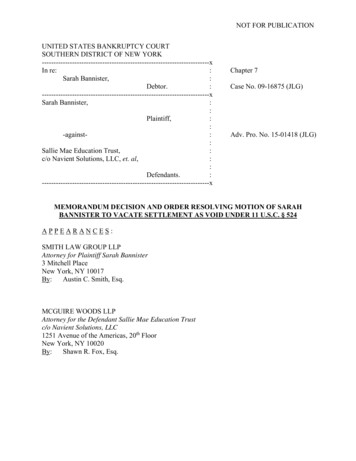
Transcription
NOT FOR PUBLICATIONUNITED STATES BANKRUPTCY COURTSOUTHERN DISTRICT OF NEW --------------------------xIn re::Sarah -----------------------------------------xSarah Bannister,::Plaintiff,::-against::Sallie Mae Education Trust,:c/o Navient Solutions, LLC, et. ---------------------------------------xChapter 7Case No. 09-16875 (JLG)Adv. Pro. No. 15-01418 (JLG)MEMORANDUM DECISION AND ORDER RESOLVING MOTION OF SARAHBANNISTER TO VACATE SETTLEMENT AS VOID UNDER 11 U.S.C. § 524APPEARANCES:SMITH LAW GROUP LLPAttorney for Plaintiff Sarah Bannister3 Mitchell PlaceNew York, NY 10017By:Austin C. Smith, Esq.MCGUIRE WOODS LLPAttorney for the Defendant Sallie Mae Education Trustc/o Navient Solutions, LLC1251 Avenue of the Americas, 20th FloorNew York, NY 10020By:Shawn R. Fox, Esq.
HON. JAMES L. GARRITY, JR.U.S. BANKRUPTCY JUDGEIntroductionSarah Bannister (the “Debtor”) is a chapter 7 debtor herein. She is indebted to NavientSolutions, Inc. (“Navient”) in the sum of approximately 125,000 on account of five TuitionAnswer Loans (collectively, the “Navient Loans”) to her daughter. That indebtedness (the“Navient Debt”) is evidenced by five promissory notes (the “Navient Notes”). The Debtor filedthis adversary proceeding in part to obtain a hardship discharge of the Navient Debt undersection 523(a)(8) of the Bankruptcy Code (the “Adversary Proceeding”). The Debtor andNavient did not litigate the matter to a conclusion. Instead, they settled the litigation by agreeingin substance that the Navient Loans are nondischargeable education loans under section523(a)(8) of the Bankruptcy Code, payable in a reduced amount over an extended period of time,at a fixed rate of interest (the “Stipulation for Settlement”). On May 31, 2017, the Courtapproved that settlement. The ma)tter before the Court is the Debtor's motion to vacate theStipulation for Settlement as void under section 524 of the Bankruptcy Code (the "Motion").1Navient objects to the Motion (the “Objection”).2 For the reasons stated herein, the Courtsustains the Objection and denies the Motion.Jurisdiction1See Amended Motion And Memorandum of Law In Support Of Motion To Vacate Settlement As Void UnderSection 524 [ECF No. 101 (Adv. Pro. 15-01418)] and Plaintiff’s Reply In Further Support Of The Motion To VacateSettlement As Void [ECF No. 116 (Adv. Pro. 15-01418)] (the “Reply”). Citations to “ECF No. (Adv. Pro. 1501418)” refer to documents filed of record in this adversary proceeding. Citations to “ECF No. (09-16875)” referto documents filed in the main case.2See Objection to Amended Motion To Vacate Settlement As Void Under Section 524 [ECF No. 114 (Adv.Pro. 15-01418)] (the “Objection”); the Declaration of Joseph Florczak In Support Of Objection To Amended MotionTo Vacate Settlement As Void Under Section 524 (the “Florczak Decl.”); and Defendant’s Sur-Reply To Plaintiff’sReply In Further Support Of The Motion To Vacate Settlement As Void [ECF No. 118 (Adv. Pro. 15-01418)] (the“Sur-Reply”).
This Court has jurisdiction over the Motion pursuant to 28 U.S.C. §§ 1334(a) and 157(a)and the Amended Standing Order of Referral of Cases to Bankruptcy Judges of the United StatesDistrict Court for the Southern District of New York (M-431), dated January 31, 2012 (Preska,C.J.). This matter is a core proceeding under 28 U.S.C. § 157(b)(2)(I).Facts3On November 18, 2009, the Debtor filed a voluntary petition under chapter 7 of theBankruptcy Code (the “Petition”) herein.4 The Schedules annexed to the Petition did not includeany student loan obligations. On May 24, 2010, the Debtor received her discharge inbankruptcy.5 On May 10, 2012, the Debtor filed a motion to reopen her chapter 7 case in order toinclude the Navient Debt within the scope of her chapter 7 discharge due to hardship.6 On May22, 2012, the Court granted Debtor’s motion and reopened the case.7 On December 12, 2015, theDebtor filed a Complaint commencing this Adversary Proceeding.8 On December 17, 2015, theDebtor filed her Amended Complaint.9Except in cases of undue hardship, a bankruptcy discharge does not discharge a debtorfrom any enumerated education-related debt in section 523(a)(8) of the Bankruptcy Code. Insupport of the Amended Complaint, the Debtor asserts that the “adversary proceeding is brought3The Facts are not in dispute.4See ECF No. 1 (09-16875).5See ECF No. 11 (09-16875).6See ECF No. 13 (09-16875).7See ECF No. 14 (09-16875).8See Complaint Seeking Dischargeability of Plaintiff’s Student Loan Obligations [ECF No. 1 (Adv. Pro. 15-01418)].9See First Amended Complaint Seeking Dischargeability of Plaintiff’s Student Loan Obligations [ECF No. 2(Adv. Pro. 15-01418)].2
under 11 U.S.C. §523(a)(8) and Fed. R. Bankr. P. 7001,” and that she is seeking “a determinationthat [her] student loan obligations should be subject to discharge in this bankruptcy case on thebasis of undue hardship.” Amended Complaint ¶ 2. In particular, she alleges that the (i) NavientLoans are “student loan[s] within the purview of 11 U.S.C. §523(a)(8)[,]” and “[n]ot exceptingthe [Navient Loans] from discharge would result in an undue hardship for Plaintiff SarahBannister.” Id. ¶¶ 28, 29. In its answer to the Amended Complaint (the “Answer”)10, Navientadmitted that the Debtor is indebted to Navient on account of the Navient Loans (Answer ¶¶ 8,11) and that the loans are within the purview of section 523(a)(8) of the Bankruptcy Code. Id. ¶28. However, Navient denied any assertion that the Debtor suffers undue hardship, “becauseNavient is without information or knowledge sufficient to form a belief as to the truth of thisaverment.” Id. ¶ 2; see also id. ¶ 29.On May 3, 2017, Navient noticed the Stipulation for Settlement for presentment.11Without limitation, in that stipulation, the Debtor and Navient agreed that the Debtor is indebtedto Navient in the aggregate amount of 123,867.39 (the “Outstanding Balance”) on account ofthe Navient Loans, that the indebtedness is evidenced by the Navient Notes, and that the“Outstanding Balance is currently due and owing on the [Navient] Loans evidenced by the [Navient]Notes, and the [Navient] Loans evidenced by the [Navient] Notes are nondischargeable educationalloans, pursuant to 11 U.S.C. § 523(a)(8) . . . ” Stipulation for Settlement at 2. They also agreed todismiss Navient as a defendant in the Adversary Proceeding subject to the terms of the settlement,upon Court approval of the settlement. The terms of the Stipulation for Settlement include:10See Navient Solutions, Inc.’s Answer to Amended Complaint Seeking Dischargeability of Plaintiff’s StudentLoan Obligations [ECF No. 5 (Adv. Pro. 15-01418)].11See Notice of Presentment and Stipulation for Settlement Between Plaintiff and Navient Solution, Inc. andFor Dismissal of Navient Solutions, Inc. As A Defendant in the Adversary Proceeding [ECF No. 22 (Adv. Pro. 1501418)].3
For so long as Plaintiff does not default under this Stipulation, the balance shall bereduced to 90,000.00 ("Reduced Balance"), and the variable interest rate shall bereduced to a fixed rate of 1% ("Reduced Interest"), and Plaintiff shall repay theReduced Balance at the Reduced Interest rate as follows: 289.48 per month for aperiod of three hundred sixty (360) consecutive months.The following shall be Events of Default hereunder: (a) Plaintiff shall fail to makeany payment due hereunder within thirty (30) days of the due date, without securingNavient's agreement to a forbearance of such payment(s); or (b) Plaintiff commencesany further legal proceedings against Navient, its successors or assigns.Upon the occurrence of an Event of Default under this Stipulation, any forgiveness ofthe principal and interest is revoked, and the Plaintiff will be liable for the fullamount of the Outstanding Balance plus interest pursuant to the applicable terms ofthe Promissory Notes (less any payments made hereunder which, following defaultshall be applied first to interest that would have accrued had this Stipulation not beenin effect, and then to principal).Stipulation for Settlement ¶¶ 1, 3, 4. On May 31, 2017, the Court approved the Stipulation forSettlement and dismissed Navient from the Amended Complaint.12MotionThe Debtor contends that the Navient Loans are not qualified education loans undersection 523(a)(8) of the Bankruptcy Code because, among other things, the Debtor did not incurthem to pay qualified higher education expenses, and they exceeded the student’s cost ofattendance. See Motion at 1, 4-12. She asserts that the Stipulation for Settlement constitutes aninvalid reaffirmation agreement and is void ab initio because all of the Navient Loans or some ofthem had been discharged in the Debtor’s chapter 7 case and because the stipulation does notsatisfy the requirements of section 524(c) of the Bankruptcy Code. Id. at 1-2. The Debtor arguesthat, as she prepares to file a petition under chapter 13 of the Bankruptcy Code, Navient should12See Order Approving Stipulation for Settlement Between Plaintiff and Navient Solutions, Inc. andDismissing Navient Solutions, Inc. as a Defendant in this Adversary Proceeding [ECF No. 23 (Adv. Pro. 15-01418)].4
not be permitted to recover through her anticipated chapter 13 plan indebtedness that waspreviously discharged by the Court. Id. at 1.In opposing the Motion, Navient contends that section 524(c) is not applicable to thisCourt ordered settlement of the Adversary Proceeding embodied in the Stipulation forSettlement, and that the stipulation controls the dischargeability of the Navient Loans. It assertsthat is so because the Stipulation for Settlement operates as a waiver of dischargeability, as itspecifically identified the Navient Loans as nondischargeable education loans under section523(a)(8). Objection at 2-3. It also asserts that as section 524(c) is not applicable to thestipulation, the Debtor’s only avenue for relief from the Stipulation for Settlement is throughRule 60(b) of the Federal Rules of Bankruptcy Procedure (“Rule 60(b)”).13 Navient maintainsthat the Debtor cannot demonstrate grounds for relief from the Stipulation for Settlement underRule 60(b). Id. at 4-7.In her Reply, the Debtor argues that section 524 is not applicable herein because in itsObjection, Navient conceded that the Navient Debt has been discharged. Reply at 2-3. She alsocontends that the Stipulation for Settlement is a “consent decree,” and not a “judgment,” and thatthe “exceptional circumstances” standard under Rule 60(b) is not relevant to the issue of theenforcement of the Stipulation for Settlement. Id. at 3-5. Below, the Court considers thesematters and the Debtor’s contentions regarding the application of section 524 to the Stipulationfor Settlement.Discussion13Rule 60(b) is made applicable herein by Federal Rule of Bankruptcy Procedure 9024.5
In the Motion, the Debtor argues, at length, why, in her view, the Navient Loans aredischargeable under section 523(a)(8) of the Bankruptcy Code. See Motion at 2-13.14 TheDebtor contends that because Navient makes no attempt in its Objection to rebut any of thosearguments, the Court should conclude that Navient has conceded that the Navient Debts aredischargeable and were indeed discharged in her chapter 7 case. Reply at 2-3. In doing so, theDebtor relies on cases that support the proposition that in appropriate circumstances, a court mayinfer from a party’s conduct in the course of litigation that it has abandoned claims or defensesthat it could assert in that litigation.15 That principle is not applicable herein because thequestion of whether the Navient Loans are dischargeable debts under the Bankruptcy Code is notat issue in the Motion. At issue is whether the Court should void the Stipulation for Settlement.Navient was not bound to rebut any of the Debtor’s contentions regarding the dischargeability ofthe Navient Loans. Moreover, and in any event, in its Objection and Sur-Reply, Navientmaintains that the Navient Debt is not dischargeable in bankruptcy. It notes that in each of theNavient Loans, the Debtor conceded that the loans were issued and expressly conditioned uponthe use of loan proceeds for qualified education expenses.1614As noted, in the Amended Complaint, the Debtor alleges that the Navient Loans are “student loan” withinthe scope of section 523(a)(8) of the Bankruptcy Code. See Amended Complaint ¶ 28. Debtor was represented bycounsel in filing the Amended Complaint. She has new counsel for this Motion.15See Reply at 2 (citing Hallmark Licensing, LLC v. Dickens, Inc., Case No. 17CV2149SJFAYS, 2020 WL6157007, at *9 (E.D.N.Y. Oct. 21, 2020) (“A court may, when appropriate, infer from a party’s partial oppositionthat relevant claims or defenses that are not defended have been abandoned.”); Camarda v. Selover, 673 F. App'x26, 30 (2d Cir. 2016) (“Even where abandonment by a counseled party is not explicit, a court may inferabandonment from the papers and circumstances viewed as a whole.”); Patacca v. CSC Holdings, LLC, Case No.16CV0679SFJARL, 2019 WL 1676001, at *13 (E.D.N.Y. Apr. 17, 2019) (collecting cases).16As support, Navient points to the certifications in the loan documents executed by the Debtor. Sur-Reply at2 (citing Ex. A to Florczak Decl. at PDF p. 20 (Aug. 2005 Promissory Note Section N 2); id. at PDF pg. 26 (Feb.2006 Promissory Note Section N 2.); id. at PDF pg. 35 (July 2006 Promissory Note Section P.5); id. at PDF pg. 45(Oct. 2006 Section P.5); id. at PDF pg. 58 (Jul. 2007 Promissory Note Section Q.2).6
The Court next considers whether section 524 governs the enforceability of theStipulation for Settlement. Section 727 of the Bankruptcy Code governs a chapter 7 debtor'sdischarge in bankruptcy. See 11 U.S.C. § 727. Section 727(a) states the general rule that "[t]hecourt shall grant the debtor discharge" and thereafter lists twelve exceptions to that general rule.Section 727(b) provides that except as provided in section 523 of the Bankruptcy Code:a discharge [section 727(a)] discharges the debtor from all debts that arose beforethe date of the order for relief under this chapter, and any liability on a claim thatis determined under section 502 of this title as if such claim had arisen before thecommencement of the case, whether or not a proof of claim based on any such debtor liability is filed under section 501 of this title, and whether or not a claim basedon any such debt or liability is allowed under section 502 of this title.11 U.S.C. § 727(b). Section 523 of the Bankruptcy Code lists the “Exceptions to discharge,” andsection 524 governs the “Effect of discharge.” In general, a creditor must commence anadversary proceeding during the pendency of the bankruptcy case to determine whether a debt isexcepted from the discharge of an individual debtor under section 523. See 11 U.S.C. § 523(c).“If no complaint is timely filed, the exception is lost, and the debt is discharged under § 727.” Inre Haroon, 313 B.R. 686, 689 (Bankr. E.D. Va. 2004).Student loans are generally nondischargeable. However, section 523(a)(8) containsexceptions to that general rule, as follows:unless excepting such debt from discharge under this paragraph would impose anundue hardship on the debtor and the debtor's dependents, for(A)(i) an educational benefit overpayment or loan made, insured, or guaranteedby a governmental unit, or made under any program funded in whole or inpart by a governmental unit or nonprofit institution; or(ii) an obligation to repay funds received as an educational benefit,scholarship, or stipend; or7
(B) any other educational loan that is a qualified education loan, as defined insection 221(d)(1) of the Internal Revenue Code of 1986, incurred by a debtor whois an individual;11 U.S.C. § 523(a)(8). This section is self-executing. "A student loan creditor is not required toseek a dischargeability determination during the pendency of the bankruptcy case. The failure toseek a dischargeability determination does not alter the fact that the debt is or is not dischargedupon entry of the discharge order. It merely avoids a judicial declaration of that fact at that time."In re Haroon, 313 B.R. at 689. See also In re McDaniel, 590 B.R. 537, 552 (Bankr. D. Colo.2018), aff’d and remanded, 97 F.3d 1083 (10th Cir. 2020) (holding the dischargeability ofstudent loan debts under section 523(a)(8), which is self-executing, is not altered by the choice ofeither party to forgo commencing an adversary proceeding and proceeding at their own risk); 4Collier on Bankruptcy, 11523.04 (16th ed. revised 2020) ("There are no specific time deadlinesimposed by the Code or the Federal Rules of Bankruptcy Procedure for the determination of thedischargeablity of a debt with respect to section 523(a) discharge exception other than thosearising under subsections 523(a)(2), (4) and (6).”).Pursuant to section 524(a) of the Bankruptcy Code, a bankruptcy discharge voids anyjudgment of personal liability with respect to any debt discharged under the BankruptcyCode, whether or not discharge of such debt is waived, and operates as an injunction againstactions to collect any such debt as a personal liability of the debtor. See 11 U.S.C. § 524(a)(1),(a)(2). A debtor can waive those protections and reaffirm debts on a debt-by-debt basis,provided that it satisfies sections 524(c) and (d) of the Bankruptcy Code. See 11 U.S.C. §§524(c), (d). See also In re Bagbag, 595 B.R. 164, 169 (Bankr. S.D.N.Y. 2018) (“the BankruptcyCode permits a debtor to reaffirm a debt that otherwise would be discharged, but it imposes strictlimits on the manner in which a debtor may do so."); In re Collins, 243 B.R. 217, 219 (Bankr. D.8
Conn. 2000) (“A reaffirmation agreement is enforceable only if it is in writing and satisfiescertain other statutory criteria.”) (citing 11 U.S.C. §§ 524(c), (d)).Section 524(c) provides the only means by which a debtor can reaffirm an otherwisedischargeable debt. See In re Cruz, 254 B.R. 801, 813 (Bankr. S.D.N.Y. 2000) (noting that areaffirmation agreement that complies with section 524(c) is the only manner in which a liabilityon a pre-petition debt can survive a discharge). See also In re Beschloss, Case No. 15-12139,2018 WL 2138276, at *2 (Bankr. S.D.N.Y. May 8, 2018) (emphasizing that the point of section524(c) is to protect debtors who promise to make payments on discharged debts by saying thatthose promises are unenforceable unless certain conditions are met."). Under that section, “[a]nagreement between a holder of a claim and the debtor, the consideration of which, in whole or inpart, is based on a debt that is dischargeable in a case under this title is enforceable whether ornot discharge of such debt is waived” only under specific conditions. 11 U.S.C. § 524(c). Onesuch provision is that “such agreement was made before the granting of a discharge undersection 727 [of the Bankruptcy Code].” Id. § 524(c)(1). Without limitation, to be enforceablethese agreements also must be filed with the court and must contain "a clear and conspicuousstatement" that the debtor may revoke the agreement within 60 days of its filing (or untildischarge, whichever occurs later). Id. §§ 524(c)(3), (c)(4). If the debtor was represented by anattorney during the negotiation of the agreement, the attorney must include an affidavit recitingthat the debtor was fully informed about the agreement and that it does not impose an unduehardship on him or his dependent. Id. § 524(c)(3).The Debtor filed her Petition on November 18, 2009. She did not identify any of theNavient Loans in the Petition. A student loan is not discharged in a chapter 7 bankruptcy case9
unless the Court determines that repayment of the debt would constitute an undue hardship. 11U.S.C. § 523(a)(8).Until a judicial determination is made of “undue hardship,” educational debts arepresumptively nondischargeable, meaning that it is incum
Solutions, Inc. (“Navient”) in the sum of approximately 125,000 on account of five Tuition Answer Loans (collectively, the “Navient Loans”) to her daughter. That indebtedness (the “Navient Debt”) is evidenced by five
